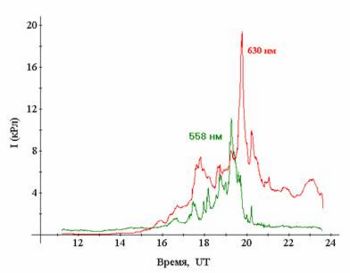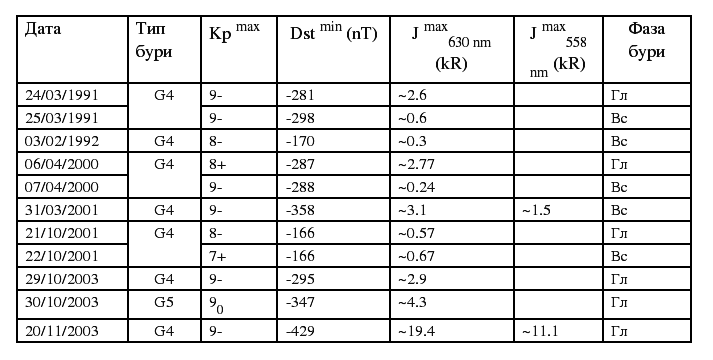Institute of Solar-Terrestrial Physics of Siberian Branch of Russian Academy of Sciences (ISTP SB RAS)
Mid-latitude auroras during geomagnetic storms in the south of Eastern Siberia on 29-31 October and 20-21 November 2003
From ISTP SB RAS
[edit] Mid-latitude auroras in the south of Eastern Siberia
[edit] Mid-latitude auroras during geomagnetic storms in the south of Eastern Siberia on 29-31 October and 20-21 November 2003
Mid-latitude auroras were observed during two strong geomagnetic storms in the south of Eastern Siberia (the ISTP SB RAS Geophysical Observatory, 520N, 1030 E) on 29-31 October and 20-21 November 2003. According to the NOAA classification (http://sec.noaa.gov/NOAAscales/index.html) and Kp-index, these storms are of G4- and G5-types (extremely strong).
Two energetic solar flares of Х17.2 and Х10 types, considered most powerful since 1976, preceded the geomagnetic storm on 29-31 October 2003. According to the Dst-index determinative for mid-latitude auroras, the 29-31 October storm is giant. In accordance with (http://swdcdb.kugi.kyoto-u.ac.jp/dstdir/dst1/q/Dstqthism.html), preliminary minimum Dst-index value was < - 429 nT>. As for the 20 November 2003 magnetic storm with Dst min = - 429 nT, only 4 magnetic storms (13 September 1957, 11 February 1958, 15-16 July 1959, and 13-14 March 1989) had comparable or lower Dstmin values. The minimum Dst-index value of the 11 February 1958 geomagnetic storm was < - 426 nT> and was followed by a well-known planetary middle-latitude aurora.
Preliminary estimation of 558 and 630 nm emission rates registered in the Geophysical Observatory on 20 November 2003 was ~ 11 kR and ~ 19 kR, respectively (Fig. 1). Maximum 630 nm-emission rates observed on 30 November 2003 were ~ 4.3 kR. These were highest emission-rate values registered in the ISTP SB RAS Geophysical Observatory over the optical observation period of 1989–2003 (Table 1).
Preliminary analysis of observation results of the 20 November 2003 mid-latitude aurora, possible mechanisms of mid-latitude aurora formation, magnetic storm statistics based on the Dst-index, and peculiarities of the recorded spectral composition enable us to assume that the said mid-latitude aurora may be considered as one of the extreme ones ever observed both in the ISTP SB RAS observatory’s latitude and other longitude-latitude zones. This aurora may be added to the Great aurora list (http://magbase.rssi.ru/REFMAN/SPPHTEXT/great_aurora.html)
Table 1. Mid-latitude auroras observed at the ISTP SB RAS Geophysical Observatory during strong geomagnetic storms.
- This page has been accessed 3,689 times.

